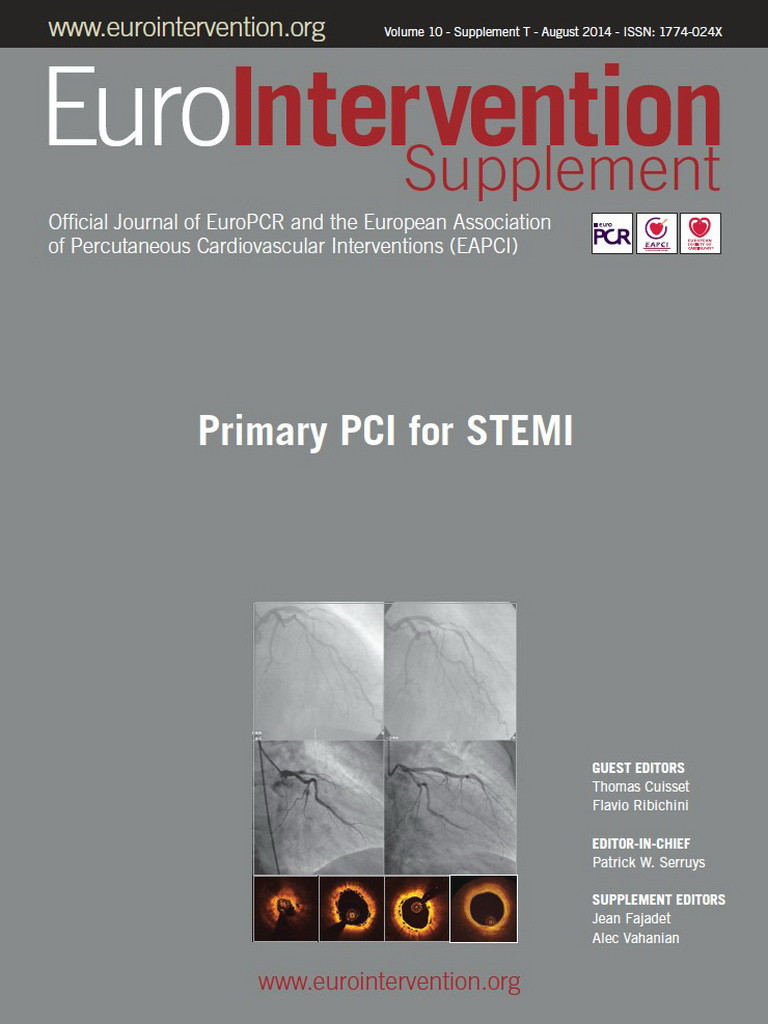Understanding the past, building the future
Invasive approaches for the management of patients with STEMI were applied even before percutaneous transluminal coronary angioplasty (PTCA) was introduced. At that time (the late seventies), the pros and cons of infusing streptokinase intravenously or directly into the coronary artery were heavily debated. Recognising that thrombus formation was responsible for the coronary occlusion, mechanical approaches were soon tested, including PTCA. However, technology and pharmacotherapy were in their infancy1. The story repeated itself when stents became available, and again, in spite of the bulkiness of those early devices and delivery systems, trials and errors were reported and discussed2. Yet the paradigm shifted when primary PCI was proven safer and more efficacious than thrombolytic therapies. However, the fundamental objection against any invasive approach to acute STEMI intervention was lack of realism. Never would it be possible to develop a dense enough network of invasive facilities available 24/7 that would be reachable in time by the majority of patients in a city or region, let alone a country. This objection remains valid today in large parts of the world. The 1993 “Illusion of reperfusion” editorial by Lincoff and Topol3 acted as an eye-opener for many, devising a number of principles that remain essential today, emphasising timely “myocardial reperfusion” as the goal to be achieved by any means, mechanical, pharmacological or both. Look at where we are today: STEMI networks have been implemented all over the world, inspired by best practice examples4. These networks are delivering the best possible care that is available locally, be it primary PCI, thrombolytic therapy, early invasive diagnosis followed by stenting as required, secondary prevention for all. Pockets of resistance remain, sometimes in areas or large cities where capacity to deliver proper care is available, but organisation or collaboration failed to meet the challenge. Yet, successful implementation of STEMI networks does matter and quickly results in measurable changes in delivery of care and patient outcomes for the better5-7.
Work in progress
Several targets for future research and implementation can be listed under three main areas: network optimisation, procedure optimisation, addressing new needs. Many of these are discussed in this special issue of EuroIntervention.
NETWORK OPTIMISATION
Caring for the acutely sick under tight time constraints requires continuous evaluation and improvement of the processes in place. The efficiency of STEMI networks may benefit greatly from pre-hospital diagnosis, and hence pre-hospital treatment. The efficiency of ambulance teams can be boosted with the proper use of point-of-care devices, distance diagnosis and communication. Challenges to the organisation of work schedules caused by unplanned procedures, half being performed at night or during the weekend, need to be addressed. Evaluation of the network performance is most useful when reported to all team members. An important duty of the network is to engage society at large, including referring hospitals and their administrators, patients and their organisations, the general public and, eventually, healthcare payers and politicians.
PROCEDURE OPTIMISATION
Primary percutaneous coronary interventions (PCI) continue to require further improvements in order to deliver superior patency of the epicardial coronary arteries and reduced myocardial reperfusion injury. Primary PCI is often associated with distal embolisation of plaque debris and thrombus, jeopardising the extent of myocardial salvage.
A number of debated questions need further assessment: choice of access site, use of mechanical thrombus aspiration and management of high thrombus load in general, management of mildly stenotic culprit lesions, identification and treatment of non-culprit stenoses in STEMI patients with multivessel disease, and optimal antithrombotic pharmacotherapy, to name the essential items. In addition, the role of dedicated stents in reducing embolisation, the value of coronary scaffolds and various interventions aiming at myocardial protection also require further investigation. More attention is needed to link macrocirculatory and microcirculatory interventions to myocardial outcomes at tissue level.
ADDRESSING NEW NEEDS
The implementation of an efficient STEMI network reveals hitherto unanticipated needs and opportunities. Many patients, who previously would not have survived a heart attack, now reach the hospital and present with cardiogenic shock, anoxic cerebral damage, or after a resuscitated cardiac arrest8. Information and consent procedures are adjusted to these new situations. Multidisciplinary teams need to become familiar with the use of neuroprotective measures and various assist devices for haemodynamic support. Once the capacity is offered, referring physicians may request early invasive diagnosis and intervention for an increasing number of patients with high-risk acute coronary syndrome and NSTEMI. Rare disease entities, such as the Tako-Tsubo syndrome, are increasingly being recognised. As a result, the scope of activities in the catheterisation laboratories has changed with 60-80% of the load now addressing the unplanned treatment of patients presenting with acute coronary artery disease.
Lastly, as the spectrum of interventional medicine is expanding, primary PCI networks may be ideally suited to offer acute intervention to selected patients suffering from ischaemic stroke. When addressing the interventional community during the opening session at EuroPCR 2012, leaders of the neurointerventional community encouraged interventional cardiologists to consider joining forces. To some extent, a parallel can be drawn between STEMI and stroke. In selected subsets, early mechanical intervention gives outstanding results, but so far these procedures are only performed in a very small number of centres worldwide. Involving the capacity of the primary PCI network in the care of stroke patients and inviting neurologists, neurosurgeons and interventional radiologists to join the multidisciplinary team has the potential to contribute to improving the dismal outcomes of the disease10.
In summary, the purpose of this supplement of EuroIntervention is to stimulate our thinking and motivate continued clinical investigation of interventional reperfusion therapy. In addition to this publication, PCR is ready to make its entire educational armamentarium, including tools and resources generated during Courses, available to the interventional community to achieve this goal. As such, this supplement of the Journal is nothing short of a call for more action.
Conflict of interest statement
The author has not conflicts of interest in relation to this editorial.

